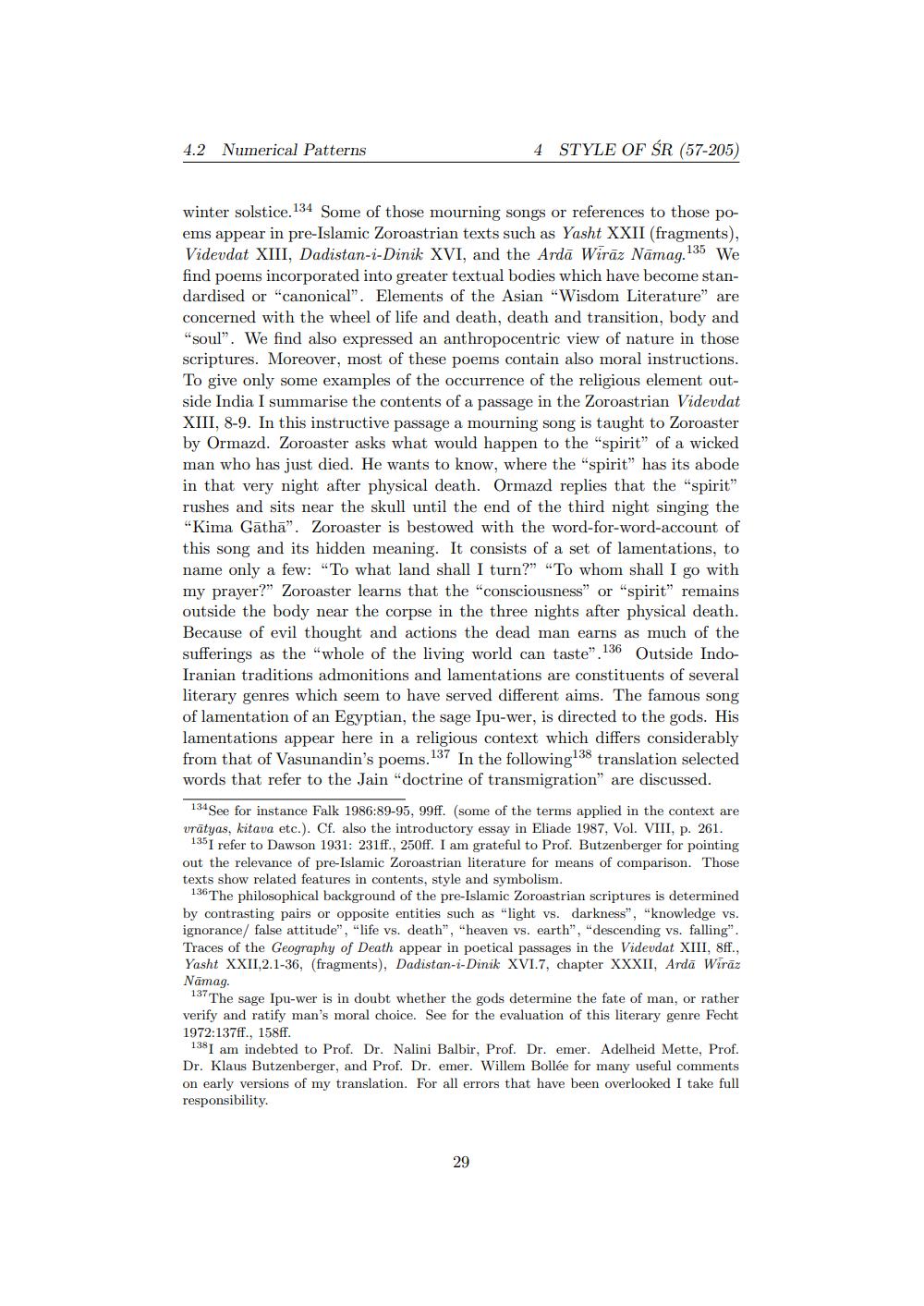________________
4.2 Numerical Patterns
4 STYLE OF ŚR (57-205)
winter solstice.134 Some of those mourning songs or references to those poems appear in pre-Islamic Zoroastrian texts such as Yasht XXII (fragments), Videvdat XIII, Dadistan-i-Dinik XVI, and the Ardā Wirāz Nāmag.135 We find poems incorporated into greater textual bodies which have become standardised or "canonical". Elements of the Asian "Wisdom Literature” are concerned with the wheel of life and death, death and transition, body and "soul". We find also expressed an anthropocentric view of nature in those scriptures. Moreover, most of these poems contain also moral instructions. To give only some examples of the occurrence of the religious element outside India I summarise the contents of a passage in the Zoroastrian Videvdat XIII. 8-9. In this instructive passage a mourning song is taught to Zoroaster by Ormazd. Zoroaster asks what would happen to the "spirit" of a wicked man who has just died. He wants to know, where the "spirit" has its abode in that very night after physical death. Ormazd replies that the "spirit" rushes and sits near the skull until the end of the third night singing the "Kima Gātha". Zoroaster is bestowed with the word-for-word-account of this song and its hidden meaning. It consists of a set of lamentations, to name only a few: "To what land shall I turn?" "To whom shall I go with my prayer?" Zoroaster learns that the "consciousness" or "spirit" remains outside the body near the corpse in the three nights after physical death. Because of evil thought and actions the dead man earns as much of the sufferings as the "whole of the living world can taste". 136 Outside IndoIranian traditions admonitions and lamentations are constituents of several literary genres which seem to have served different aims. The famous song of lamentation of an Egyptian, the sage Ipu-wer, is directed to the gods. His lamentations appear here in a religious context which differs considerably from that of Vasunandin's poems. 137 In the following138 translation selected words that refer to the Jain "doctrine of transmigration" are discussed.
134 See for instance Falk 1986:89-95, 99ff. (some of the terms applied in the context are urātyas, kitava etc.). Cf. also the introductory essay in Eliade 1987, Vol. VIII, p. 261.
1351 refer to Dawson 1931: 231ff., 250ff. I am grateful to Prof. Butzenberger for pointing out the relevance of pre-Islamic Zoroastrian literature for means of comparison. Those texts show related features in contents, style and symbolism.
136 The philosophical background of the pre-Islamic Zoroastrian scriptures is determined by contrasting pairs or opposite entities such as "light s. darkness", "knowledge vs. ignorance/ false attitude”, "life vs. death", "heaven vs. earth", "descending vs. falling". Traces of the Geography of Death appear in poetical passages in the Videvdat XIII, 8ff., Yasht XXII.2.1-36, (fragments), Dadistan-i-Dinik XVI.7, chapter XXXII, Ardā Wirāz Nāmag.
13 The sage Ipu-wer is in doubt whether the gods determine the fate of man, or rather verify and ratify man's moral choice. See for the evaluation of this literary genre Fecht 1972:137ff., 158ff.
138I am indebted to Prof. Dr. Nalini Balbir, Prof. Dr. emer. Adelheid Mette, Prof. Dr. Klaus Butzenberger, and Prof. Dr. emer. Willem Bollée for many useful comments on early versions of my translation. For all errors that have been overlooked I take full responsibility.




